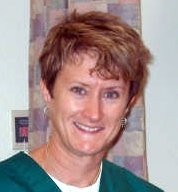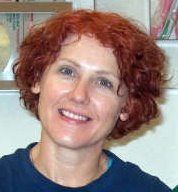It is Friday,
 May 26th in Phoenix with Lisa. Hey everyone, Lisa’s husband Richard here, dad's driving back from Illinois and can't get to a computer; so it falls to me to give you all the good news that Lisa’s Baclofen pump went in this morning without a hitch. As dad mentioned in his last update, this medicine promises to remove the last major obstacle to Lisa’s beginning her rehab in earnest. In the test earlier this week, Lisa responded extremely well to a very small dose after just a couple of hours. So well, in fact, that Dr. Kwasnica (dad, please not the correct spelling) discontinued the trial. The doctor is "excited" about Lisa’s prospects.
May 26th in Phoenix with Lisa. Hey everyone, Lisa’s husband Richard here, dad's driving back from Illinois and can't get to a computer; so it falls to me to give you all the good news that Lisa’s Baclofen pump went in this morning without a hitch. As dad mentioned in his last update, this medicine promises to remove the last major obstacle to Lisa’s beginning her rehab in earnest. In the test earlier this week, Lisa responded extremely well to a very small dose after just a couple of hours. So well, in fact, that Dr. Kwasnica (dad, please not the correct spelling) discontinued the trial. The doctor is "excited" about Lisa’s prospects.Let me thank all of you for your prayers, thoughts and support, and for keeping them coming, Lisa’s got a lot of work ahead, and having your cards, notes and e-mails to read (to her) and literally post is a real blessing. In particular I’d like to thank Lisa’s Father-In-Law, Mother, Uncle & Aunt for their support, and effort to visit Lisa.
Baclofen is taken orally as a pill or delivered directly into an area of the spine called the intrathecal (intra-the-cal) space. The intrathecal space contains the cerebrospinal fluid -- the fluid surrounding the spinal cord and nerve roots. Often MS patients (and those like Lisa) receive intrathecal Baclofen because oral Baclofen causes unpleasant side effects, such as confusion, weakness, and sleepiness. But intrathecal Baclofen delivers the drug right to the target site in the spinal cord. Since the medication does not circulate throughout the body, only tiny doses are required to be effective. Therefore, side effects are minimal.
The intrathecal Baclofen pump system is the way doctors give the drug directly into the spinal fluid. The system consists of a catheter (a small, flexible tube) and a pump. The pump -- a round metal disc, about one inch thick and three inches in diameter -- is surgically placed under the skin of the abdomen near the waistline. The pump stores and releases prescribed amounts of medicine through the catheter. With a programmable pump, a tiny motor moves the medication from the pump reservoir through the catheter. Using an external programmer, your treatment team can make adjustments in the dose, rate, and timing of the medication.
* The information about Baclofen is from “WebMD.COM.” The article I used is from the originated from the Cleveland Clinic; and appears on the Internet: http://www.webmd.com/content/article/57/66125.htm.
As I report these recent events to you, it’s late Monday evening; Richard and Michael are back from their extended weekend visit with Lisa. Now, over the weekend, Richard had a meeting those attending were Donna Cheek, Deb Pope and Christine Kwasnica (note the corrected spelling of Christine’s last name) The topic discussed was how to best provide the skilled, staff levels required Lisa to control spasticity during the time it will take the Baclofen to reach its therapeutic level.
As of now, Spasticity has not had it way with Lisa, as she has not suffered p
 ermanent injury from it. Richard’s meeting came about after the hospital’s chief executive officer pulled two key Restorative Aides from Lisa’s bedside and their ranging therapy. Yolanda and Bruce, the aides, were effectively ranging her and holding back the effects of spasticity. Commenting on why the aides were dismissed, the CEO said, “… their assignment to Lisa was not cost effective (or words to that effect).” Meanwhile the meeting continued and Deb Pope, Therapy Supervisor, and a person who has great concern for patient care, stepped up and offered to personally range Lisa. Then Richard, to make up for the staffing shortfall hired Yolanda privately after clearing the hire with the CEO. Additionally, Sherry with her medical expertise expects to also be involved in ranging her, and who knows, I could be a resource. We will be in Phoenix with Michael over the coming June weekends. This incident puts a face on the conundrum hospital administrators have been complaining about for a long time as they deal with the issues to solve the balance of providing healthcare services and its companion, the cost to provide the service. This is a head-up should you or a loved one be faced with a future hospital admission (my personal editorial opinion).
ermanent injury from it. Richard’s meeting came about after the hospital’s chief executive officer pulled two key Restorative Aides from Lisa’s bedside and their ranging therapy. Yolanda and Bruce, the aides, were effectively ranging her and holding back the effects of spasticity. Commenting on why the aides were dismissed, the CEO said, “… their assignment to Lisa was not cost effective (or words to that effect).” Meanwhile the meeting continued and Deb Pope, Therapy Supervisor, and a person who has great concern for patient care, stepped up and offered to personally range Lisa. Then Richard, to make up for the staffing shortfall hired Yolanda privately after clearing the hire with the CEO. Additionally, Sherry with her medical expertise expects to also be involved in ranging her, and who knows, I could be a resource. We will be in Phoenix with Michael over the coming June weekends. This incident puts a face on the conundrum hospital administrators have been complaining about for a long time as they deal with the issues to solve the balance of providing healthcare services and its companion, the cost to provide the service. This is a head-up should you or a loved one be faced with a future hospital admission (my personal editorial opinion).“Lisa, what’s wrong?” Richard asked, as he could see Lisa face was flushed. From past experience, Richard knew something was bothering her. He guess right the first time, “Surgery, is it the surgery that worries you?” Lisa, whose eyes were wide open, closed them for a long blink. This had become the sign for “Yes!” Lisa whose pillow was restricting head movement, chose to use her eyes to communicate. Richard then continued. He walked her through the surgery. She came to understand how it would benefit her. Much of Lisa has not changed. One thing that hasn’t is that surgery is not among her favorite things, as her personal experience with it is very limited. She still has her tonsils and appendix. Anyway, Lisa understood the why of it, and came on board with a Big Blink. You’ve got to love the team work between these two. Richard said, “after they paused a while, she seemed calmer and reassured.
Tomorrow (now today, as I continue writing this) Richard leaves (left) for Ada, Oklahoma. He will be there during June. You may contact him at the following number: (520) 419-5857, if he doesn’t answer, please leave a message. Remember he will be in trial so don’t expect an immediate reply.
You have really helped Lisa and the family with your prayers, acts of kindness, and well wishes. At the risk of going to the well one time too many, I want to ask you to include Lindley Bliss, MD who is Lisa’s attending physician at the hospital. Dr. Bliss coordinates her medical care. He’s been a superior, solid guy, who is kind, compassionate, and quick to respond. Today, (yesterday) he slipped on a wet spot in the hospital cafeteria fell and broke his ankle. Please join us in our good wishes and thoughts for his speedy recovery.
Jack & Napua Davis, and David & Suzanne Goodspeed have been very supportive of Richard, especially during the recent difficult times, and for that we’re putting our kudos go to them all. You have earned the big star. Thanks folks!
It has taken a lot of support, from a lot of people, many of whom are unsung to make this giant wheel turn. I wish there was some way to give each of them a gold star!
Michael
Oro Valley, AZ (PCS)
mlwintory@msn.com
Andrew Smith (6) and Cousin Michael (3 mo.) new best buds. (during Michael's Galesburg visit.)











